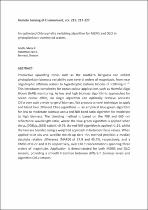 ResearchSpace
ResearchSpace
An optimized Chlorophyll a switching algorithm for MERIS and OLCI in phytoplankton-dominated waters
JavaScript is disabled for your browser. Some features of this site may not work without it.
- ResearchSpace
- →
- Research Publications/Outputs
- →
- Journal Articles
- →
- View Item
| dc.contributor.author |
Smith, Marie E

|
|
| dc.contributor.author |
Robertson, lain L

|
|
| dc.contributor.author |
Bernard, Stewart

|
|
| dc.date.accessioned | 2018-06-18T11:41:33Z | |
| dc.date.available | 2018-06-18T11:41:33Z | |
| dc.date.issued | 2018-06 | |
| dc.identifier.citation | Smith, M.E., Robertson, I.L. and Bernard, S. 2018. An optimized Chlorophyll a switching algorithm for MERIS and OLCI in phytoplankton-dominated waters. Remote Sensing of Environment, vol. 215: 217-227 | en_US |
| dc.identifier.issn | 0034-4257 | |
| dc.identifier.uri | https://doi.org/10.1016/j.rse.2018.06.002 | |
| dc.identifier.uri | https://www.sciencedirect.com/science/article/pii/S0034425718302785 | |
| dc.identifier.uri | http://hdl.handle.net/10204/10271 | |
| dc.description | Copyright: 2018 Elsevier. Due to copyright restrictions, the attached PDF file only contains the abstract of the full text item. For access to the full text item, please consult the publisher's website. | en_US |
| dc.description.abstract | Productive upwelling zones such as the southern Benguela can exhibit phytoplankton biomass variability over several orders of magnitude, from near oligotrophic offshore waters to hypertrophic inshore blooms of>100 mgm (sup-3). This introduces complexity for ocean colour applications such as Harmful Algal Bloom (HAB) monitoring. As low and high biomass algorithmic approaches for ocean colour differ, no single algorithm can optimally retrieve accurate Chl a over such a wide range of biomass. We propose a novel technique to apply and blend two different Chl a algorithms — an empirical blue-green algorithm for low to moderate biomass and a red-NIR band-ratio algorithm for moderate to high biomass. The blending method is based on the 708 and 665 nm reflectance wavelength ratio, where the blue-green algorithm is applied when the (subw)(708)/ (subw)(665) ratio is<0.75, the red-NIR algorithm is applied>1.15, whilst the two are blended using a weighted approach in between these values. When applied to in situ and satellite match-up data this method provides a median absolute relative difference (MARD) of 37.9 and 45.7%, respectively, and a RMSD of 0.27 and 0.35 respectively, over Chl a concentrations spanning three orders of magnitude. Application is demonstrated for both MERIS and OLCI sensors, providing a smooth transition between different biomass levels and algorithm Chl a returns. | en_US |
| dc.language.iso | en | en_US |
| dc.publisher | Elsevier | en_US |
| dc.relation.ispartofseries | Worklist;21007 | |
| dc.subject | OLCI | en_US |
| dc.subject | MERIS | en_US |
| dc.subject | Chlorophyll a | en_US |
| dc.subject | Southern Benguela | en_US |
| dc.subject | MSC: | en_US |
| dc.subject | 00-01 | en_US |
| dc.subject | 99-00 | en_US |
| dc.title | An optimized Chlorophyll a switching algorithm for MERIS and OLCI in phytoplankton-dominated waters | en_US |
| dc.type | Article | en_US |
| dc.identifier.apacitation | Smith, M. E., Robertson, l. L., & Bernard, S. (2018). An optimized Chlorophyll a switching algorithm for MERIS and OLCI in phytoplankton-dominated waters. http://hdl.handle.net/10204/10271 | en_ZA |
| dc.identifier.chicagocitation | Smith, Marie E, lain L Robertson, and Stewart Bernard "An optimized Chlorophyll a switching algorithm for MERIS and OLCI in phytoplankton-dominated waters." (2018) http://hdl.handle.net/10204/10271 | en_ZA |
| dc.identifier.vancouvercitation | Smith ME, Robertson lL, Bernard S. An optimized Chlorophyll a switching algorithm for MERIS and OLCI in phytoplankton-dominated waters. 2018; http://hdl.handle.net/10204/10271. | en_ZA |
| dc.identifier.ris | TY - Article AU - Smith, Marie E AU - Robertson, lain L AU - Bernard, Stewart AB - Productive upwelling zones such as the southern Benguela can exhibit phytoplankton biomass variability over several orders of magnitude, from near oligotrophic offshore waters to hypertrophic inshore blooms of>100 mgm (sup-3). This introduces complexity for ocean colour applications such as Harmful Algal Bloom (HAB) monitoring. As low and high biomass algorithmic approaches for ocean colour differ, no single algorithm can optimally retrieve accurate Chl a over such a wide range of biomass. We propose a novel technique to apply and blend two different Chl a algorithms — an empirical blue-green algorithm for low to moderate biomass and a red-NIR band-ratio algorithm for moderate to high biomass. The blending method is based on the 708 and 665 nm reflectance wavelength ratio, where the blue-green algorithm is applied when the (subw)(708)/ (subw)(665) ratio is<0.75, the red-NIR algorithm is applied>1.15, whilst the two are blended using a weighted approach in between these values. When applied to in situ and satellite match-up data this method provides a median absolute relative difference (MARD) of 37.9 and 45.7%, respectively, and a RMSD of 0.27 and 0.35 respectively, over Chl a concentrations spanning three orders of magnitude. Application is demonstrated for both MERIS and OLCI sensors, providing a smooth transition between different biomass levels and algorithm Chl a returns. DA - 2018-06 DB - ResearchSpace DP - CSIR KW - OLCI KW - MERIS KW - Chlorophyll a KW - Southern Benguela KW - MSC: KW - 00-01 KW - 99-00 LK - https://researchspace.csir.co.za PY - 2018 SM - 0034-4257 T1 - An optimized Chlorophyll a switching algorithm for MERIS and OLCI in phytoplankton-dominated waters TI - An optimized Chlorophyll a switching algorithm for MERIS and OLCI in phytoplankton-dominated waters UR - http://hdl.handle.net/10204/10271 ER - | en_ZA |





